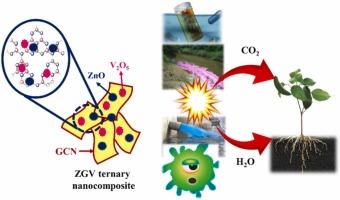Synergistic effect of dual Z-scheme ZnO/g-C3N4/V2O5 heterogeneous nanocomposite for photocatalytic decontamination of mixed dye and pharmaceutical drugs under visible light irradiation
IF 6.3
2区 材料科学
Q2 CHEMISTRY, PHYSICAL
引用次数: 0
Abstract
In this study, ZnO/g-C3N4/V2O5 (ZGV) nanocomposite were constructed via facile wet impregnation method. The prepared samples were comprehensively studied by XRD, FT-IR, BET, Raman, SEM, XPS, UV–vis. absorption, PL spectroscopic and DLS analysis. From various obtained results it is confirmed that the ZnO and V2O5 nanoparticles were well dispersed on the surface of g-C3N4 nanosheets. The energy bandgap of ZGV nanocomposite was tuned from 3.18 eV to 2.06 eV, provides an improved visible light absorption ability and exhibited with immense cutdown on the photogenerated charge carrier’s recombination rate. So that the ZGV photocatalyst showed remarkable degradation performance against mixed dye with 4.3 (Rh B) and 5.6 (MB) folds and tetracycline (4.8) times higher than pure and binary nanocomposite samples under visible light irradiation. The enhanced photocatalytic performance pertained by the nanocomposite was owed to the synergetic effect of heterostructure formation with efficacy charge separation along with dual Z-scheme charge transfer mechanism. Furthermore, the radicals responsive for photocatalytic activity are elucidated by free radical trapping experiment. Eventually, the prominent stability and recyclability of ZGV photocatalyst was confirmed by 5 consecutive recycle runs. The antibacterial test against Streptococcus pneumoniae, Pseudomonas aeruginosa, Escherichia coli, and Bacillus cereus were investigated. The toxicity measurement by using treated water for plant growth also revealed. Based on the results, this work suggests that the rational design and construction of heterostructure nanocomposite possess significant potential on highly efficient and reusable visible light photocatalysts for the purification of environment and energy conversion process.

双Z-scheme ZnO/g-C3N4/V2O5非均相纳米复合材料在可见光下光催化去污混合染料和药物的协同效应
本研究采用易湿浸渍法制备ZnO/g-C3N4/V2O5 (ZGV)纳米复合材料。采用XRD、FT-IR、BET、Raman、SEM、XPS、UV-vis等方法对制备的样品进行了全面研究。吸收,PL光谱和DLS分析。各种实验结果证实了ZnO和V2O5纳米粒子在g-C3N4纳米片表面分散良好。ZGV纳米复合材料的能带从3.18 eV调整到2.06 eV,提高了可见光吸收能力,并显著降低了光生载流子的复合速率。在可见光下,ZGV光催化剂对含有4.3 (Rh B)和5.6 (MB)折叠的混合染料和4.8倍的四环素的降解性能比纯纳米复合材料和二元纳米复合材料高。纳米复合材料光催化性能的增强是由于异质结构的形成与有效电荷分离以及双Z-scheme电荷转移机制的协同作用。此外,通过自由基捕获实验对自由基的光催化活性进行了研究。ZGV光催化剂的稳定性和可回收性在连续5次循环中得到验证。进行了对肺炎链球菌、铜绿假单胞菌、大肠杆菌和蜡样芽孢杆菌的抑菌试验。还揭示了利用处理过的水进行植物生长的毒性测定。本研究结果表明,合理设计和构建异质结构纳米复合材料在高效、可重复使用的可见光催化剂环境净化和能量转化过程中具有重要的潜力。
本文章由计算机程序翻译,如有差异,请以英文原文为准。
求助全文
约1分钟内获得全文
求助全文
来源期刊

Journal of Alloys and Compounds
工程技术-材料科学:综合
CiteScore
11.10
自引率
14.50%
发文量
5146
审稿时长
67 days
期刊介绍:
The Journal of Alloys and Compounds is intended to serve as an international medium for the publication of work on solid materials comprising compounds as well as alloys. Its great strength lies in the diversity of discipline which it encompasses, drawing together results from materials science, solid-state chemistry and physics.
 求助内容:
求助内容: 应助结果提醒方式:
应助结果提醒方式:


